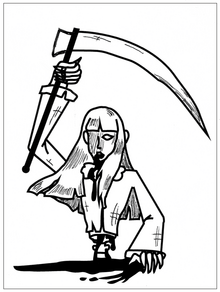Teke Teke

Teke Teke (テケテケ),[1] also spelled Teke-Teke,[2] Teketeke,[3] or Teke teke,[1] is a Japanese urban legend about the ghost of a young woman or schoolgirl who is said to have fallen onto a railway line, where her body was cut in half by a train. She is an onryō, or a vengeful spirit, who lurks in urban areas and around train stations at night. Since she no longer has a lower body, she travels on either her hands or elbows, dragging her upper torso and making a scratching or "teke teke"-like sound. If she encounters an individual, she will chase them and slice them in half at the torso, killing them in such a way that mimics her own disfigurement.[4]
Overview
Common elements of the legend include that "Teke Teke" is the vengeful ghost or spirit (also known as an onryō) of a young woman or schoolgirl who was executed by being sliced in half. Missing her lower extremities, she is said to walk on her hands or her elbows, making a scratching or "Teke Teke"-like sound as she moves. If an individual encounters Teke Teke at night, she will chase them and cut their body in half (often with a scythe), mimicking her own death.
One version of the story concerns a young woman known as Kashima Reiko, who is said to have died when her legs were severed from her body by a train after she fell on the tracks.[5][6] According to legend, her legless spirit haunts bathroom stalls, asking occupants if they know where her legs are.[5] If a questioned individual replies with an answer that Kashima does not find acceptable, she will rip or cut their legs off.[7] Individuals may survive the encounter by replying that her legs are on the Meishin Expressway,[7][8] or by responding with the phrase "kamen shinin ma", or "mask death demon" (which may be the phonetic root of Kashima's name).[9][7]
See also
- Aka Manto ("Red Cape"), a Japanese urban legend about a spirit which appears in bathrooms
- Hanako-san, a Japanese urban legend about the spirit of a young girl who haunts school bathrooms
- Kuchisake-onna ("Slit Mouth Woman"), a Japanese urban legend about a disfigured woman
- Miss Koi Koi, an African urban legend of a ghost who haunt schools
- Sadako Yamamura, a ghost from the Ring novels and films
- Teketeke (film), a 2009 film based on the urban legend
References
- ^ a b Meyer, Matthew (31 October 2015). "Teke teke". Yokai.com. Retrieved 12 July 2019.
- ^ "Teke-Teke - Japanese Urban Legends". ScaryForKids.com. 24 November 2014. Retrieved 12 July 2019.
- ^ Murguía 2016, p. 317.
- ^ de Vos 2012, p. 170.
- ^ a b Meza-Martinez, Cecily; Demby, Gene (31 October 2014). "The Creepiest Ghost And Monster Stories From Around The World". NPR. National Public Radio, Inc. Retrieved 6 August 2019.
- ^ Fierro, Romina. "Teke Teke: el fantasma japonés que aterra a quienes caminan por las estaciones de tren" [Teke Teke: the Japanese ghost that terrifies those who walk through train stations]. Vix.com. Retrieved 6 August 2019.
- ^ a b c Grundhauser, Eric (2 October 2017). "Get to Know Your Japanese Bathroom Ghosts". Atlas Obscura. Retrieved 12 July 2019.
- ^ Bricken, Rob (19 July 2016). "14 Terrifying Japanese Monsters, Myths And Spirits". Kotaku. G/O Media. Retrieved 6 August 2019.
- ^ Bathroom Readers' Institute 2017, p. 390.
Further reading
- Bathroom Readers' Institute (2017). Uncle John's OLD FAITHFUL 30th Anniversary Bathroom Reader (Uncle John's Bathroom Reader Annual). Portable Press. ISBN 978-1684120864.
{{cite book}}: Invalid|ref=harv(help) - de Vos, Gail (2012). What Happens Next? Contemporary Urban Legends and Popular Culture. Libraries Unlimited. ISBN 978-1598846331.
{{cite book}}: Invalid|ref=harv(help) - Murguía, Salvador Jimenez (2016). The Encyclopedia of Japanese Horror Films (National Cinemas). Rowman & Littlefield Publishers. ISBN 978-1442261662.
{{cite book}}: Invalid|ref=harv(help)
